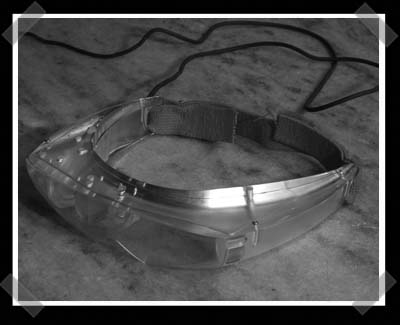
[Ozan] sent in his first attempt at making his own heads up display. The optics are very simple in design, and he gutted a commercial heads up display (ICUITI) for the LCD panel and interface electronics. I haven’t played with many head mounted displays since the Nintendo virtual boy. I’m not up on my field of view calculations, so it’s difficult to equate this to a commercial headset.
16 thoughts on “Glasses Heads-up Display”
Leave a Reply
Please be kind and respectful to help make the comments section excellent. (Comment Policy)














Isn’t using an existing one kind of cheating?
We are using an off-the-shelf microdisplay. The optics and the shell are all custom designed and fabricated.
this is totally kick-ass. imagine with two of them you could make some pretty sweet 3-d graphics.
Thank you. Stereo will be a next step.
that looks pretty awesome- is it feasible to take pictures of it in action? I guess it wouldn’t really translate to a digital camera that well.
have you considered adding a camera and using the display for vision augmentation? I know one of the companies that comes to recruitment fairs at my uni are very proud of their real-time video edge detector… instant Tron-vision glasses :)
Thanks. Yes, it is indeed difficult to take a high quality shot of it in action. We are going to try to take pictures of the image formed through the system with a pinhole camera for a large depth of field and see if that works better than digital cameras.
Very nice design, however, I remeber various companies venturing into wearable optics about 10 years back (Nintendo, Iomega, etc.) and I thought there had been problems with severe eyestrain, headaches and even disorientation. Is that something that you’ve addressed with the see-thru design or is it just a “don’t wear them for too long” style fix?
Very nice, price tag in the ICUTI alone is rather high, however. What do you expect the $ range for this the be?
If you want to see the real-deal, check these out:
http://www.microvision.com/miloverview.html
I demo’d their ND2100 ( http://www.microvision.com/mil2100.html ) unit, and all I can say is “wow”. Nevermind that the unit I tried was monochrome-red, it was great. The image appeared right in front of me, huge, and sort of transparent.
I’m sure they cost a fortune, but it was nice.
Couple of good quotes come to mind:
that’s no hack…that’s a space station!
this hack is beyond any of us.
RUN!!!
Seriously. _wow_ Well done!
There are issues in stereo devices known as the accomodation/convergence conflict. Our eyes have evolved to focus and converge at the same point. In stereo devices, the optics usually map a single object plane to a single image plane with high quality. In a head-worn display, in order to see the image, we always have to focus on the image plane. However, we need to converge in order to perceive depth. For example, if we are displaying a virtual object closer than the image plane, our eyes would focus on the image plane (so we can see) and converge closer so we can perceive 3d. You can find some numbers in the literature related to the magnitude of this mismatch. Some approaches have been proposed to overcome this conflict. To my understanding an optical solution to the accomodation/convergence conflict that is compact & mobile remains an open problem, while waiting for the ultimate solution along with everyone else, we are learning more about these devices and will keep prototyping them. I would also like to warn you that I am not a vision scientist.
one correction: I tried to say “tolerable magnitude of this mismatch” above.
Guzel olmus Ozan
Let me know when there’s an actual guide to building one of these yourself, ok?
what kind of images can it display? how do other devices connect to it or is it all just what’s in the system already? hooking this up to some kind of body-suit-pressure sensor (to know when you’re hit and from where type of stuff) and simulated “health” meters would be cool for some real-life gaming simulations =-P
what am i talking about?! just make it compatible with laser tag packs and add that much more to the game